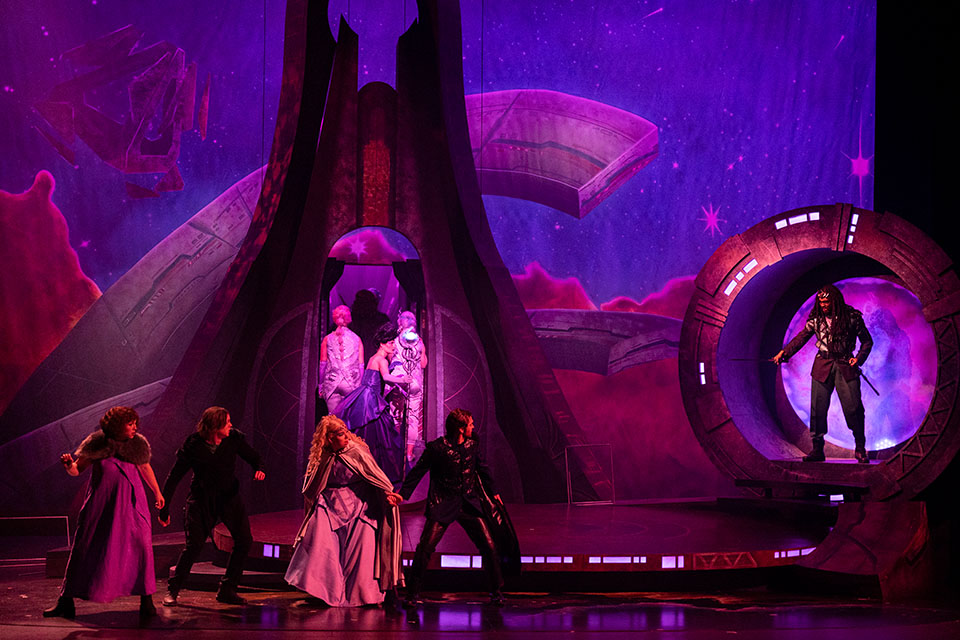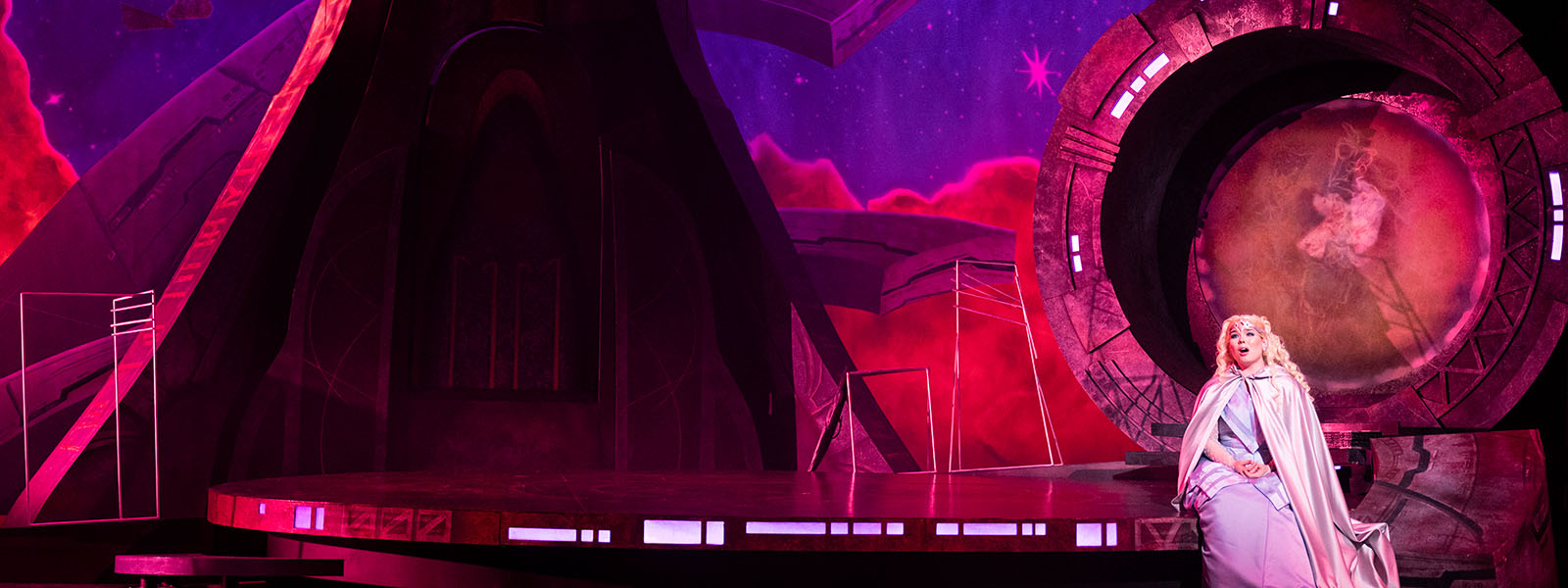Scene Designer Gisela Estrada creates out-of-this-world setting for Haydn opera
A meeting of classical composer Joseph Haydn and the Marvel Universe, A.J. Fletcher Opera Institute’s “Orlando Paladino” landed at the Stevens Center for three out-of-this-world performances this month. First performed nearly 250 years ago, Haydn’s most successful opera is based on an epic poem by Ludovico Ariosto, with a plot and characters that brought to mind superheroes doing battle in a distant galaxy for Fletcher Artistic Director Steven LaCosse.
“It’s a fantasy,” says LaCosse, the opera's stage director. “It can take place anywhere, at any time. You would not want to move a historical piece out of period. You wouldn’t set ‘A Streetcar Named Desire’ in Detroit, Michigan, but I thought this story would be fun in a futuristic setting.”

"I’m glad I had the freedom to create this universe and imagine the sets to support the story." - Gisela Estrada, scene designer for "Orlando Paladino" / Photo: Allison Lee Isley
It was fun for Scene Designer Gisela Estrada, a third-year graduate student from El Salvador. By the time she and others from the School of Design and Production (D&P) met with LaCosse via Zoom in August, she had read the script many times and was familiar with the story. She then embarked on a crash course that included multiple viewings of “Thor: Ragnarok,” a 2017 blockbuster film from Marvel Studios, and a trip to Disney’s “Star Wars” attraction.
“When Steve suggested something like ‘Thor,’ I thought, ‘this will be cool,’” says Estrada, who previously was scene designer for the rock musical “Passing Strange” presented by the School of Drama in March 2022. “Orlando Paladino” has also been a lot of work, with three different sets – one for each act – and many props that didn’t already exist in the D&P collection.
“If a knight is supposed to carry a sword, you can’t make that a gun,” LaCosse says. There are no references for what Purgatory looks like or what a space-age sorceress might wear to meet a queen. All of the scenic elements, costumes and props sprang to life from the fertile imaginations of D&P students, with lighting to set the mood and spark the magic.
A rom-com with monsters and duels
“Orlando Paladino” is a fantasy, and also a heroic romantic comedy. French knight Orlando Paladino is madly in love with Angelica, Queen of Cathay. He is ready to fight anyone who thwarts his romantic plans, primarily Rodomonte, King of Barbary, who adores Angelica and seeks to protect her from Orlando’s obsessive jealousy. Hiding with her true love, Medoro, Angelica enlists the help of a powerful sorceress, Alcina, whose tricks include installing a magic cage, summoning monsters and transporting Orlando to the Gates of Hell. Meanwhile, Orlando’s squire, Pasquale, is starving for affection and a good hot meal. At the same time, Medoro is knee-deep in trouble after gallantly diverting Orlando from the lovers’ hiding place.
“It’s a lot,” says Estrada. The Marvelesque setting required a different backdrop for each act as the characters move not from room to room but from one planet to another and then to the underworld. There’s a tower with a secret feature for Angelica’s dramatic entrance, asteroids, an intergalactic transporter, futuristic armor and musical instruments, a magic book, a monster and a boat suitable for navigating infernal waterways. There’s even a funny bird flying around, trying to avoid ending up as Pasquale’s dinner. All were created on a limited budget within the confines of an academic year.
Estrada worked closely with Lighting Designer Petko Novosad, who constructed some elements using special effects lighting and embellished other scenic elements and props. “At one point, Alcina imprisons Orlando in a cage. We couldn’t build a cage, so Petco made a magic cage with lighting. A lot of Alcina’s tricks use lighting,” she says.
“I have enjoyed the process a lot,” Estrada adds. “I also enjoy doing period designs, but I liked representing the story more abstractly. It was more fun. I’m glad I had the freedom to create this universe and imagine the sets to support the story.”
Magic is made of big ideas and close collaborations
“Orlando Paladino” is Estrada’s first opera as designer, but John Coyne, director of the Scene Design program, knew she was the right person for the job. “What we love about Gisela as a grad student designer is that she is very bold. She will try big ideas,” he says.
Estrada grew up in the world of ballet. Her mother owns a dance studio, and her brother is a dancer. “She’s been surrounded by ballet her whole life,” Coyne adds. “When we saw her portfolio, her work had this grand scale. It looked like classical ballet and we knew it would be adaptable to opera.”
Estrada recalls that during her portfolio review for admission, Coyne strongly encouraged her to see an opera. “I had seen a lot of theater growing up but no opera,” she says. “So I went to Houston Grand Opera to see ‘Aida’ and it really opened my eyes,” she says. “It was beautiful.”
Like Coyne and about a third of applicants for the graduate scene design program, Estrada has an undergraduate degree in architecture. Coyne says that provides an understanding not only of structure but also the space which informs the live performance. It also offers a sense of proportion and an eye for detail. “Architectural training helps you see the details and how they contribute to the bigger picture and the story,” he says.
Estrada came to the United States four years ago, searching for a graduate program in architecture, but soon pivoted to scene design. “I love theater, especially musical theater, bringing stories to life through music and movement. I decided that I want to connect everything I love,” she says, demonstrating on a model how her design allows the performers to move safely and naturally – and in some cases magically – on the set.
I love theater, especially musical theater, bringing stories to life through music and movement. I decided that I want to connect everything I love.
Scene Designer Gisela Estrada
The goal for this show was for the audience to be moved – perhaps enchanted – as well, Estrada explains. Through close collaboration with Lighting Designer Novosad, perspective was altered by the direction of lighting on a transparent scrim. An asteroid that appeared in the background of Act One took on special importance later.
“The audience was always wondering what will happen next,” Estrada says. “It’s super exciting.”
As busy as she was creating a magical opera set, Estrada is excited to see what comes next. She would like to stay in the U.S. to work in musical theater, at least for a while. "I want to work and continue learning from the best in the business. Then I would love to return home to El Salvador and give my country what I have learned here,” she says.
In the meantime, while the audience for "Orlando Paladino" was surely enchanted by the sets and lighting, the Fletcher Fellows also enthralled them. LaCosse says each opera is chosen to showcase and develop graduate opera students' vocal talents. “Ultimately, each opera is chosen according to what our students need to build their skillsets,” he says. “This was a fabulous choice for Fletcher Opera.”
Get the best news, performance and alumni stories from UNCSA.
SUBSCRIBE TO OUR NEWSLETTERS(OPENS IN NEW TAB)(OPENS IN NEW TAB)(OPENS IN NEW TAB)(OPENS IN NEW TAB)(OPENS IN NEW TAB)(OPENS IN NEW TAB)(OPENS IN NEW TAB)(OPENS IN NEW TAB)(OPENS IN NEW TAB)(OPENS IN NEW TAB)
February 08, 2023






